LANGUAGES
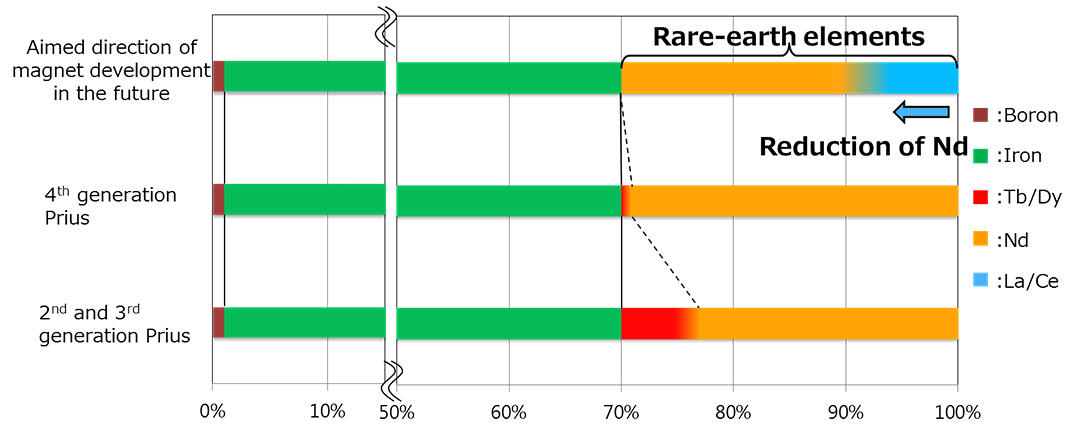
Toronto, ONTARIO, February 23, 2018―Toyota announces that it has developed the world's first*1 neodymium-reduced, heat-resistant magnet. Neodymium magnets are used in various types of motors such as the high-output motors found in electrified vehicles, use of which is expected to increase rapidly in the future. The new magnet uses significantly less neodymium, a rare-earth element*2 ("rare earth"), and can be used in high-temperature conditions.
The newly developed magnet uses no terbium (Tb) or dysprosium (Dy), which are rare earths that are also categorized as critical materials*3 necessary for highly heat-resistant neodymium magnets. A portion of the neodymium has been replaced with lanthanum (La) and cerium (Ce), which are low-cost rare earths, reducing the amount of neodymium used in the magnet.
Neodymium plays an important role in maintaining high coercivity (the ability to maintain magnetization) and heat resistance. Merely reducing the amount of neodymium and replacing it with lanthanum and cerium results in a decline in motor performance. Accordingly, Toyota adopted new technologies that suppress the deterioration of coercivity and heat resistance, even when neodymium is replaced with lanthanum and cerium, and developed a magnet that has equivalent levels of heat resistance as earlier neodymium magnets, while reducing the amount of neodymium used by up to 50 percent.
This new type of magnet is expected to be useful in expanding use of motors in various areas such as automobiles and robotics, as well as a maintining a balance between the supply and demand of valuable rare earth resources. Toyota will work to further enhance performance and evaulate application in products while accelerating the development of mass production technologies, with the aim of achieving early adoption in motors used for various applications, including in automobiles and robotics.
Development of elemental technologies for motors, inverters, batteries, and other components will require steady research and development in anticipation of the future. Toyota positions these technologies as essential for electrified vehicles and will continue making steady progress in each and every area, while working to build the foundation that will support the increased use of electrified vehicles in the future.
Background of Development of the Nd-reduced, Heat-resistant Magnet
It is important that magnets used in automotive motors and other applications have high coercivity (the ability to maintain magnetization) even at high temperatures. For this reason, approximately 30 percent of the elements used in magnets are rare earths.
When powerful neodymium magnets are used at high temperatures, such as for automotive applications, terbium and dysprosium are generally added to increase high-temperature coercivity. However, terbium and dysprosium are rare and expensive metals found in locations with high geopolitical risks. Because of this, considerable efforts have been made to develop magnets that do not use these metals, and positive results have been achieved.
Production volumes of neodymium are relatively high among rare earths, but there are concerns that shortages will develop as electrified vehicles, including hybrid and battery electric vehicles, become increasingly popular in the future. Despite this, little effort has been made to address neodymium use.
To overcome these issues, Toyota successfully undertook development of technologies that can both eliminate the use of terbium and dysprosium and reduce the amount of neodymium used. Through substitution of neodymium with lanthanum and cerium, which are abundant and low-cost rare earths, high heat resistance can be maintained and loss of coercivity minimized.
Use of rare earths in neodymium magnets
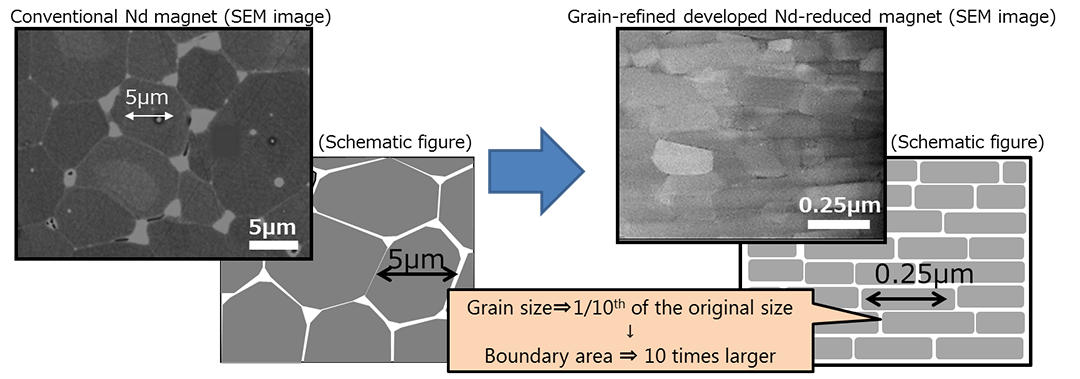
Key Points of Development of the Nd-reduced, Heat-resistant Magnet
The newly developed Nd-reduced, heat-resistant magnet is able to maintain coercivity even at high temperatures because of the combination of the following three new technologies:
Grain refinement of magnet
Two-layered high-performance grain surface
Specific alloying ratio of lanthanum and cerium
Development Point 1: Grain refinement of magnet
It is now possible to retain high coercivity at high temperatures through the reduction of the size of the magnet grains to one-tenth or less of those found in conventional neodymium magnets and the enlargement of the grain boundary area.
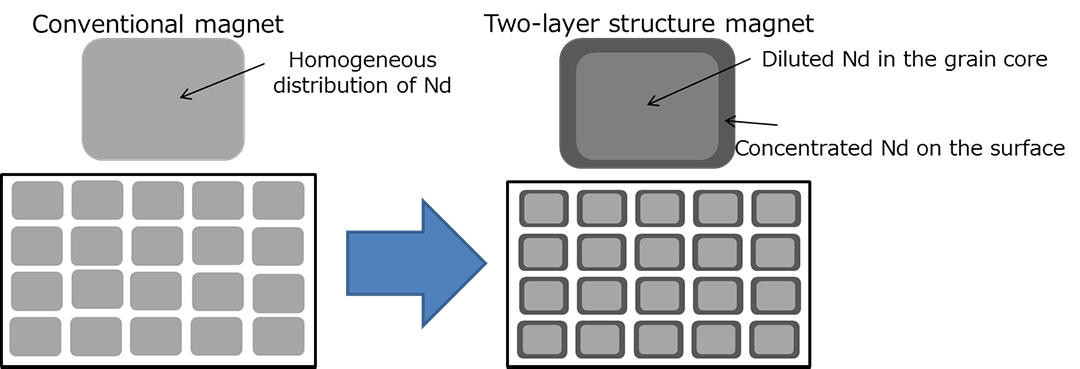
Development Point 2: Two-layered high-performance grain surface
In a conventional neodymium magnet, neodymium is spread evenly within the grains of the magnet, and in many cases, the neodymium used is more than the necessary amount to maintain coercivity. Thus, it is possible to efficiently use neodymium by increasing the neodymium concentration on the surface of the magnet grains, which is necessary to increase coercivity, and decreasing the concentration in the grain core. This results in the reduction of the overall amount of neodymium used in the new magnet.
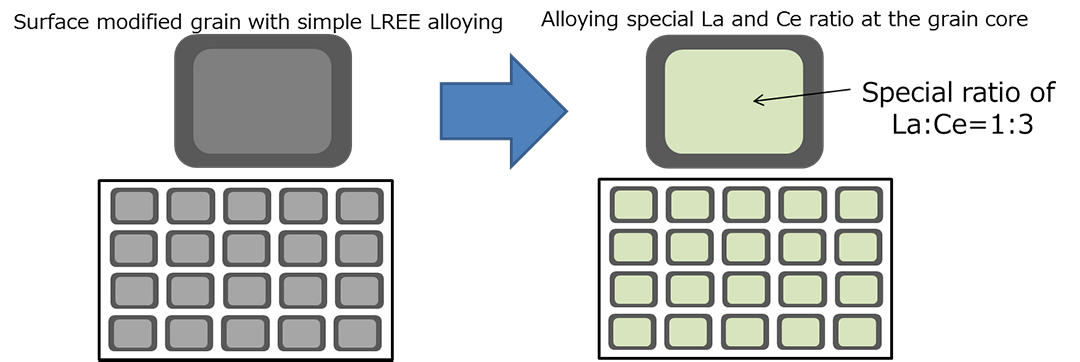
`Development Point 3: Specific ratio of lanthanum and cerium
If neodymium is simply alloyed with lanthanum and cerium, its performance properties (heat resistance and coercivity) decline substantially, complicating the use of light rare earths. As a result of the evaluation of various alloys, Toyota discovered a specific ratio at which lanthanum and cerium, both abundant and low-cost rare earths, can be alloyed so that the deterioration of properties is suppressed.
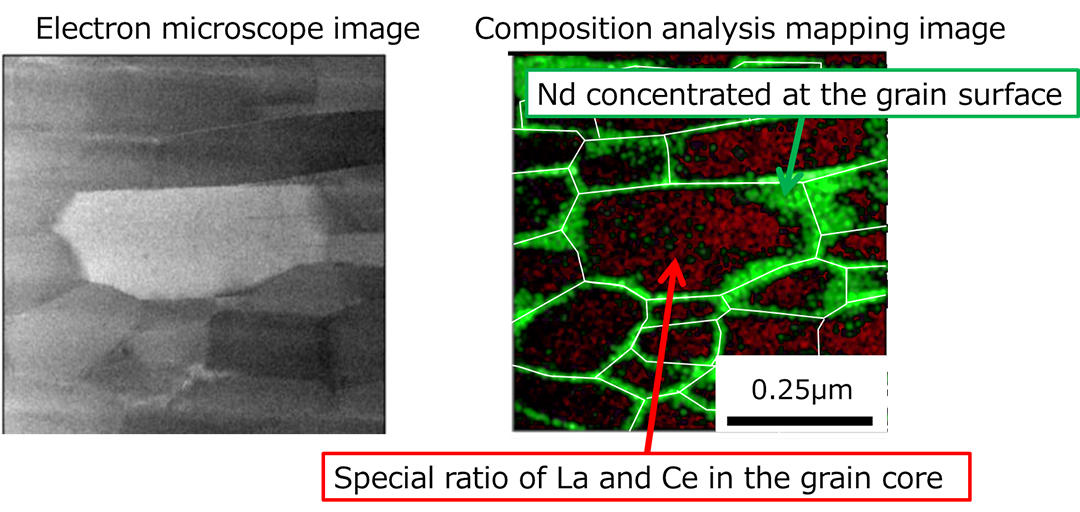
World's first Nd-reduced, heat-resistant magnet developed by simultaneously incorporating all three technologies
[Electron microscope image and composition analysis mapping image]
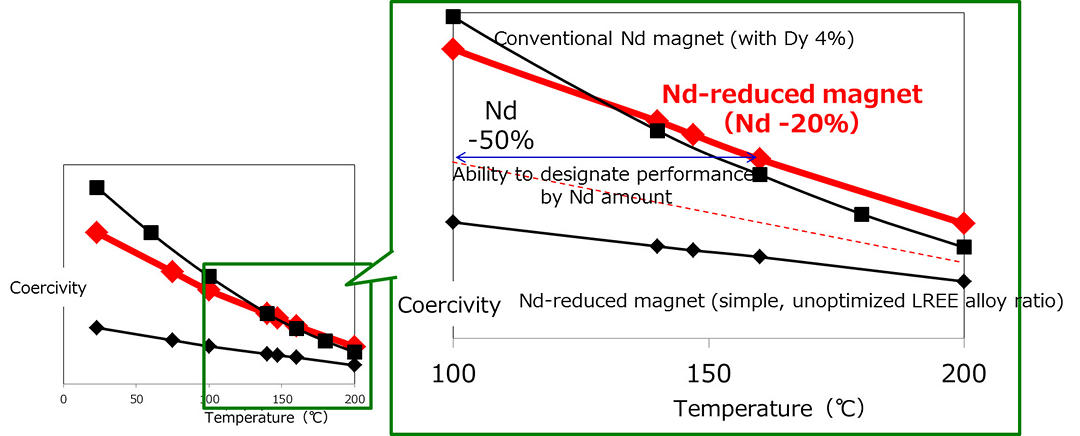
[Heat resistance performance]
Note:This research and development initiative was conducted as part of the "Development of Magnetic Material Technology for High-efficiency Motors for Next-Generation Automobiles" report issued by the New Energy and Industrial Technology Development Organization (NEDO)
Future Efforts
The new Nd-reduced, heat-resistant magnet developed at this time not only eliminates the use of terbium and dysprosium, rare earths necessary for neodymium magnets that require high heat resistance, but it also reduces the amount of neodymium used. This new magnet is expected to have a wide range of applications in motors that require relatively high output such as those required for electrified vehicle drive motors and generators, electric power steering, robots, and various household appliances. It will also contribute to reducing the risks of a disruption in supply and demand of rare earths and price increases.
Going forward, Toyota will proceed with further practical use in mind, perform application assessments in motor vehicles, and continue researching and developing technologies with the aim of low-cost, stable production.
Toyota expects that the magnets will be put to use in the motors of electric power steering for automobiles and other applications in the first half of the 2020s. Furthermore, the company will undertake development with the aim of practical application in high-performance electrified vehicle drive motors within the next 10 years.
*1As of January 2018 (Toyota Motor Corporation)
*2A group of 17 elements that have similar properties. Among the rare earths are lanthanum, cerium, neodymium, terbium, and dysprosium. It is possible for various functional materials to manifest through use of these elements.
*3Metals of which stable supply is politically important, even though relatively small amounts are present in earth's crust or extraction is difficult due to technological or economic reasons. (Ministry of Economy, Trade and Industry, Japan)
About Toyota Canada Inc.
Toyota Canada Inc. (TCI) is the exclusive Canadian distributor of Toyota and Lexus vehicles. Toyota has sold over 5 million vehicles in Canada through a national network of 287 Toyota and Lexus dealerships. Toyota is dedicated to bringing safety, quality, dependability and reliability in the vehicles Canadians drive and the service they receive. TCI’s head office is located in Toronto, with regional offices in Vancouver, Calgary, Montreal and Halifax and parts distribution centres in Toronto and Vancouver. Toyota operates two manufacturing facilities in Canada. Having produced more than seven million vehicles, popular Canadian models built at these facilities include Toyota RAV4, Toyota Corolla, Lexus RX 350 and RX 450h hybrid.
Every effort has been made to ensure the product specifications, equipment, and content on this site are accurate based on information available at time of publishing. In some cases, certain changes in standard equipment or options may occur, which may not be reflected online. Toyota Canada reserves the rights to make these changes without notice or obligation.